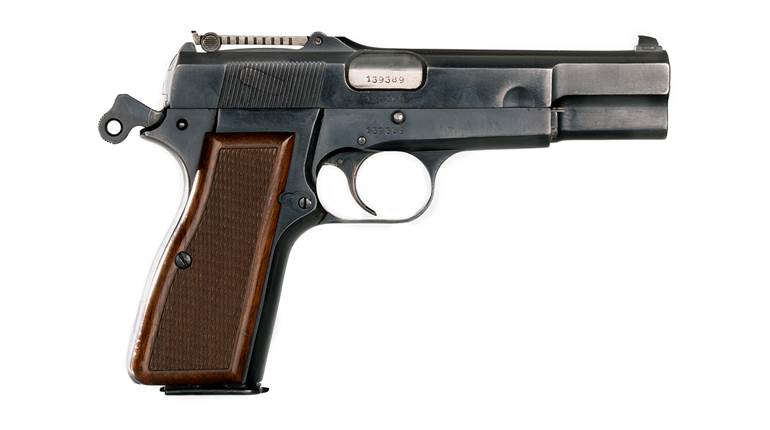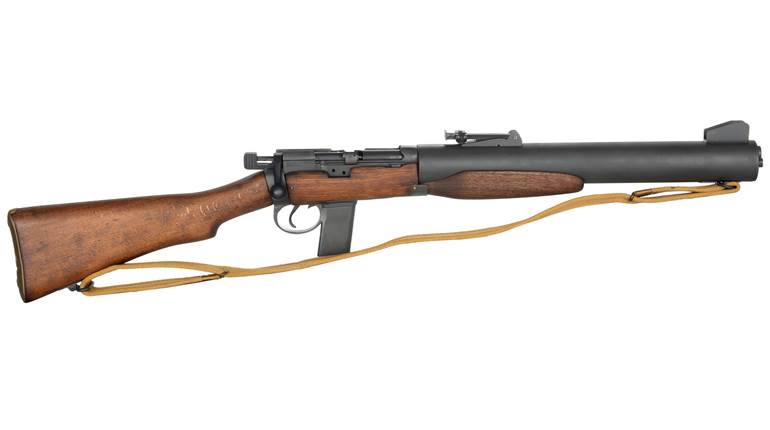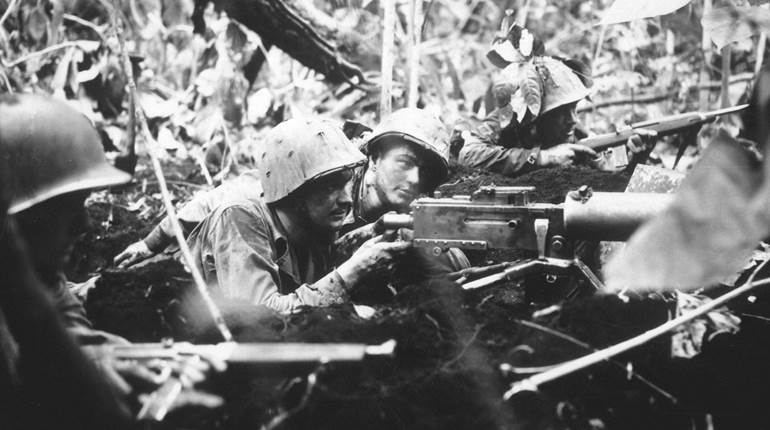
One of the most iconic American military firearms of the 20th century is the Browning Automatic Rifle (BAR). Developed by the legendary John Moses Browning, the BAR was first fielded in the closing weeks of World War I when, even during that brief period, it proved to be the best firearm of its type at the time. The BAR quickly established itself as the standard U.S. squad automatic weapon, and it served in that capacity for the next four decades.
Even though the original variant of the BAR, the Model 1918, proved to be a success, U.S. Army Ordnance continued to tinker with the gun in an attempt to increase its efficacy by adding such extraneous components as a bipod, a buttplate with folding shoulder rest, receiver magazine guides and a carrying handle. But these devices often proved to be more of a detriment than an advantage, as they added weight and bulk to an already-heavy firearm without doing a great deal to increase its effectiveness. All of the features, in addition to a problematic two-speed, automatic-only firing mechanism to replace the original selective-fire (full-automatic and semi-automatic), were incorporated into the final variant of the BAR, the Model 1918A2, which was the standard U.S. automatic rifle of World War II. It proved itself in countless engagements and was well-liked by many of the soldiers and Marines who relied on its firepower.
By that time, however, the BAR was beginning to show its age, and other automatic rifles and light machine guns were introduced—such as the British Bren—that had unmistakable advantages. The American military establishment was not unaware of the BAR’s deficiencies, including the fact that it was costly and time-consuming to manufacture, its weight was excessive and it often required an inordinate amount of maintenance in order to maintain optimum functioning. Officially, the Ordnance Dept. remained committed to the BAR but, nevertheless, explored the possibility of finding a firearm that might prove to be better. Several domestic firearm manufacturers sought to develop automatic rifles that might be sufficiently superior to the BAR for the Ordnance Dept. to take notice.
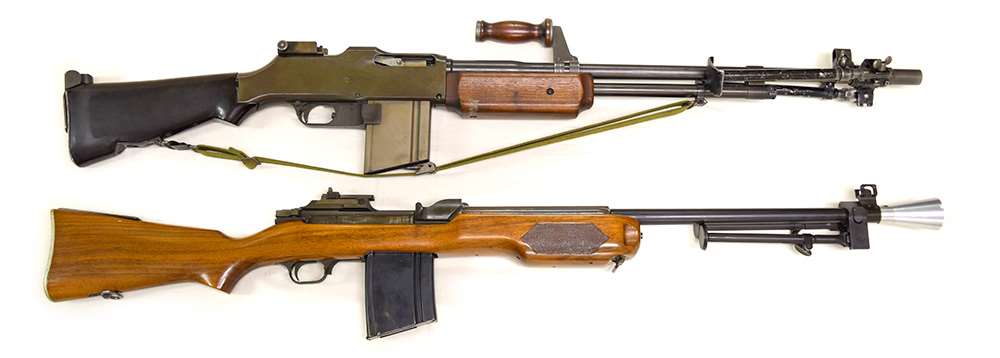
Melvin M. Johnson, Jr., developed what he termed a “light machine gun,” although it was clearly an automatic rifle. The production version of the gun, the Model 1941, was manufactured under contract for the Netherlands Purchasing Commission. The Marine Corps procured 515 M1941 Johnson Light Machine Guns from the Dutch for issuance to its elite parachute and Raider units. Also, 125 of the guns were acquired by the joint United States-Canadian First Special Service Force. The U.S. Army Ordnance Dept. showed little interest in the M1941 Johnson LMG but did acquire 10 improved “Model 1944” Johnson Light Machine Guns in 1944 for testing and evaluation, however, no subsequent orders were forthcoming. The quest to find a replacement automatic rifle had a rather low priority, as the BAR was still a serviceable small arm, and changing to another type in the middle of the war wasn’t viewed with a great deal of enthusiasm.
The Winchester Repeating Arms Co. manufactured large numbers of firearms for the American military during World War II, including the M1 Garand rifle, M1 and M2 carbines, and several types of shotguns. Even though it eventually manufactured more than a half-million M1 rifles, Winchester was never enamored with the Garand and sought to develop its own proprietary semi-automatic rifle with hopes that it might prove to be superior to the M1. Winchester developed a semi-automatic rifle based on a design of Jonathan Browning (John Moses Browning’s half-brother) that was designated by the company as the “G30M.”
The Ordnance Dept. showed little interest in the Winchester rifle, but the U.S. Marine Corps was entertaining the possibility of adopting a semi-automatic rifle, since its standard service rifle remained the bolt-action Model of 1903 Springfield. In November 1940, the Marines tested the M1 Garand, a semi-automatic rifle developed by Melvin Johnson, Jr., and the Winchester G30M. Neither the Johnson nor the Winchester rifles performed well in the tests and, although the M1 proved to be best semi-automatic tested, the Marines declined to adopt any of the rifles at the time. However, a few months later, the Corps relented and adopted the M1 rifle.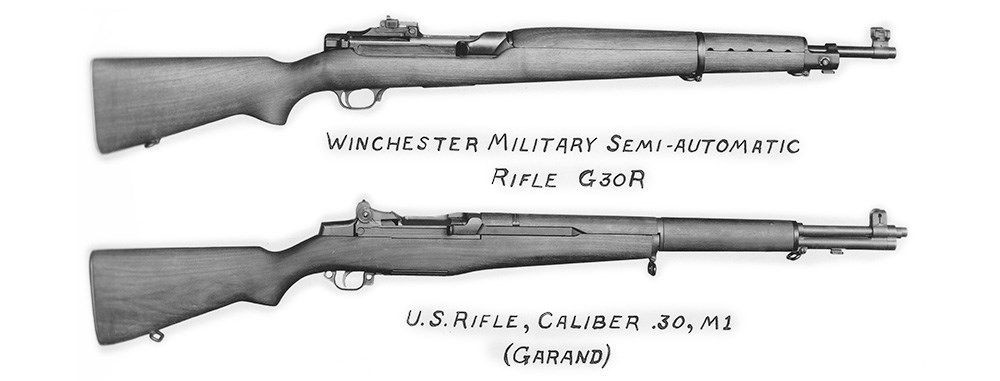
Despite the Winchester G30M’s lackluster performance in the prior Marine Corps tests, Winchester was not ready to throw in the towel on the gun, and the company’s engineers and designers went to work on refining an improved version, including the incorporation of a short-stroke gas piston designed by David Marshall Williams that was used in the design of the M1 carbine. The refined semi-automatic rifle was designated by Winchester as the G30R. This firearm had a number of interesting characteristics. The basic mechanism was, in some ways, a scaled-up version of the M1 carbine action, with a similar-pattern bolt and gas piston. Detachable box magazines were fabricated in five-, 10-, 20- and 30-round capacities.
The gun was designated as the “T10E1” by the Army, and two examples were fabricated by Winchester for testing. A May 16, 1944, letter from Maj. Gen. G.M. Barnes, chief of the technical division of the Ordnance Dept., to Winchester’s Edwin Pugsley discussed these tests, which indicated that functioning of the arm was not satisfactory, but it was believed, with some modifications, that the performance could be improved.
Pugsley and his engineers realized that the G30R rifle was not going to compete with the standard M1 Garand as a service rifle. However, it was envisioned that a modified version of the gun with selective-fire capability could perhaps supplant the BAR as the U.S. military’s standard squad automatic weapon. Such a firearm would be several pounds lighter, and easier to manufacture, than the BAR.
Based on internal Winchester documents, it appears that the idea of adapting the semi-automatic G30R rifle to be an automatic rifle was actually conceived by the Ordnance Dept. As related in a May 5, 1944, memo from Pugsley: “The Ordnance Department has for some time been insisting that we take a development contract to alter our existing .30-06 short stroke piston rifle (G30R) to be a competitor of the B.A.R.”
The Ordnance Dept. sent Winchester a letter outlining the desired characteristics of the proposed new automatic rifle that was to be based on the G30R. A subsequent memo from Pugsley summarized Ordnance’s ideas:
• “Alter mechanism so that it will be semi-automatic or full-automatic at will.
• Install a timing device that will cut the rate of fire to approximately 300 a minute.
• Make gun readily capable of disassembly so that it may be carried by paratroopers and quickly assembled, no part of the mechanism probably being over 26" long.
• Due to automatic fire, alter fore-end of stock to leave as much of barrel bare as possible for better cooling.
• Probably alter drop of stock so that recoil will be in practically straight line with butt plate. A slight drop can probably be offset by the weight of gun; all of this to prevent climbing of the muzzle.
• It possibly will be required that the magazine be same as the B.A.R. This will be difficult as B.A.R. magazines are poorly designed and cause the bulk of the troubles had with that gun. They do not present the cartridges high enough in the magazine so that the bolt can readily pick them up. We experimented considerably with the use of the standard B.A.R. before we adopted the present magazine three years ago.
• Possible addition of bipod.”
Winchester’s engineering and production staff began work on the modified G30R. The company designated the new selective-fire arm as the “WAR” (Winchester Automatic Rifle), which was a pretty nifty acronym for a military arm. The new automatic rifle, complete with bipod and muzzle brake, weighed just more than 16 lbs.—approximately 4 lbs. lighter than a comparably equipped M1918A2 BAR.
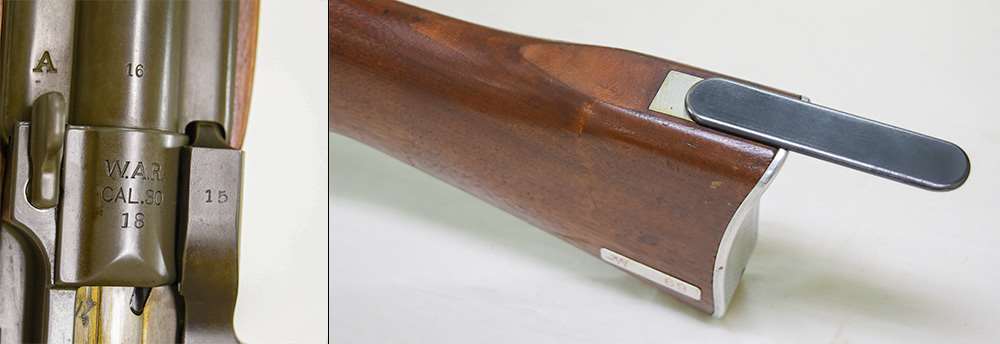
On Nov. 21, 1944, the WAR was sufficiently developed as to be informally fired by Col. René Studler at the Army’s Aberdeen Proving Ground in Harford County, Md., along with an M2 carbine and a prototype selective-fire Garand rifle that Winchester had also developed. A Winchester report stated:
“We next fired the WAR. The rate on this was taken at 585 without the flash hider and 625 with the hider. The flash hider serves to back the pressure up a bit and accounts for the higher rate of fire. This gun performed without a hitch of any kind. It was weighed and tipped the scales at 16 lbs. and 3 ozs. with flash hider and bipod (subtract 5 1/2 ozs. for sling). Col. Studler fired the gun prone on the bipod and complained that it did not feel comfortable. Two of the regular Aberdeen shooters tried it and pronounced it very comfortable. They proved to the Colonel that his trouble consisted of shooting in his raincoat and the double epaulets interfered. The Colonel agreed that this was so.”
“This gun, I believe, is on the light side of practicability as it shakes the shooter plenty, either off-hand or prone with the bipod. It would take considerable training before a man could handle the piece with any effect full automatic. We did not fire it from the hip, which might prove its best position.”
“Col. Studler tentatively set the date to being the test as November 29th, subject to confirmation. His attitude was frank and friendly.”
“Arrangements were made to have D.M. Williams return November 22nd to supervise the photographing and proof-firing.”

The more in-depth Ordnance Dept. tests that were initially slated for Nov. 22, 1944, were re-scheduled for December 5 and 6 and resumed on December 18-22. While the official tests results have not been discovered, an entry in the Winchester files on Dec. 27, 1944, read: “Col. Studler to E.P. (Edwin Pugsley) states test was sufficiently promising to warrant further investigation; asks if we can supply ten additional rifles complete with ten magazines per gun and, if so, price and delivery schedule.”
This was followed on Jan. 8, 1945, by the following memo: “E.P. to Col. Studler states we estimate cost in the neighborhood of $10,000 each but are willing to absorb all cost over $5,000. Suggests lump sum contract.” On Jan. 25, 1945, Winchester accepted Ordnance Contract No. W19-059-ORD-2542 for:
“Quantity – 10
Description – Win. Auto. Rifles, Cal. 30
Price - $5,000 each, net f.o.b. New Haven, Conn.”
The 10 WARs were completed by June 14, 1945, as evidenced by a Winchester internal document of that date that related:
“Col. Studler visits plant and about 100 rounds are fired thru two WAR’s [sic]. Advised that guns were ready for delivery and he suggests shipping two to Aberdeen and holding the other eight.”
The WARs were beautifully finished with attractive blued metal and finely crafted walnut stocks that would not have been out of place on a custom-made sporting rifle. The guns were marked on the receiver “WAR/CAL. .30/serial number/WINCHESTER/TRADE MARK.” In addition, all major parts were marked with each firearm’s one- or two-digit serial number. A finely adjustable rear sight and a buttplate with an integral rotating shoulder rest were fitted.
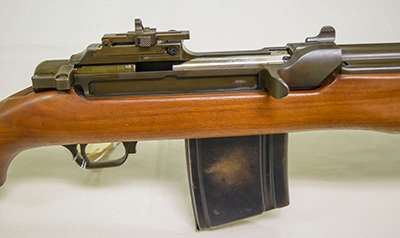
As would be expected of what were essentially prototype arms, there were several differences between some of the WARs fabricated by Winchester. At least one gun, believed to have been the one demonstrated to Col. Studler in November 1944, had a circular muzzle brake/flash suppressor and a longer bipod. Other examples, believed to have been the pattern used on the 10 WARs ordered by Ordnance in January 1945, have a conical aluminum flash hider and a bipod that could be adjusted for length. There were subtle differences in the design of the stocks, including some with checkering and some with grasping grooves in the fore-end. A 20-round detachable box magazine with a slightly curved configuration was developed for the rifle.
The first two WARs ordered by Ordnance were shipped to Aberdeen on June 15, 1945, by special messenger, where the guns were tested from June 20 through June 26. The remaining eight rifles were shipped on July 5, 1945. Some of these were subsequently sent from Aberdeen to the U.S. Army Infantry Board and the U.S. Marine Corps Equipment Board.
Apparently more than the 10 automatic rifles ordered under government contract (and the first prototype previously demonstrated to Col. Studler) were manufactured by Winchester, as serial numbers as high as “18” have been observed. Known as “over-runs,” it was not unusual for manufacturers to fabricate more examples than initially contracted for in order to have extras on hand for additional testing or demonstration.
Almost a month then passed, and Pugsley still had not heard from the Ordnance Dept. regarding the results of the Aberdeen tests of the WARs. On Aug. 3, 1945, he contacted Col. Studler to inquire as to the status of the situation. Studler replied on Aug. 8 that, “ … tests of the using arms of Service have not been received.” By this time, it was apparent that World War II was all but over, which obviously took a lot of the urgency out of the search for a better automatic rifle. Nevertheless, the Winchester staff wanted to know the status of their WAR, and Pugsley contacted Col. Studler again on Sept. 13, 1945, but there is no record of a response.

Although the WAR was a finely engineered and meticulously crafted firearm that showed a lot of potential, the timing could not have been worse for Winchester. Almost immediately after V-J Day, all Ordnance research and development work was halted. After the war, work resumed on some small arms, especially a selective-fire service rifle, but Winchester’s Automatic Rifle was not on the list for further evaluation and testing. Thus, Winchester’s proprietary selective-fire automatic rifle died with the end of World War II. The WAR was over.
The M1918A2 BAR continued to be the standard U.S. squad automatic weapon during the Korean War and saw some use well into the Vietnam conflict. Its role was eventually taken over, to some extent, by the selective-fire M14 rifle and the M60 machine gun. A number of the WARs currently reside at the Springfield Armory National Historic Site Museum and the Cody Firearms Museum.
While the WAR never came close to supplanting the BAR, it is nevertheless a most interesting design. One can speculate what might have happened if the WAR had been developed in 1942 instead of the closing months of World War II. Would it have been accepted as a replacement for the BAR, or would it have been just another firearm that showed potential but never made it to the “big leagues?”













